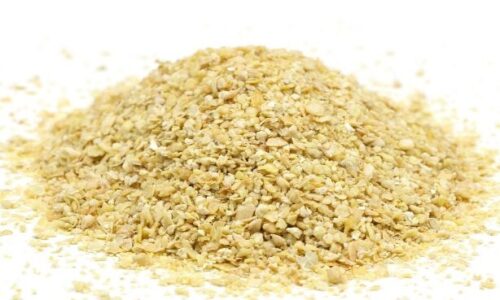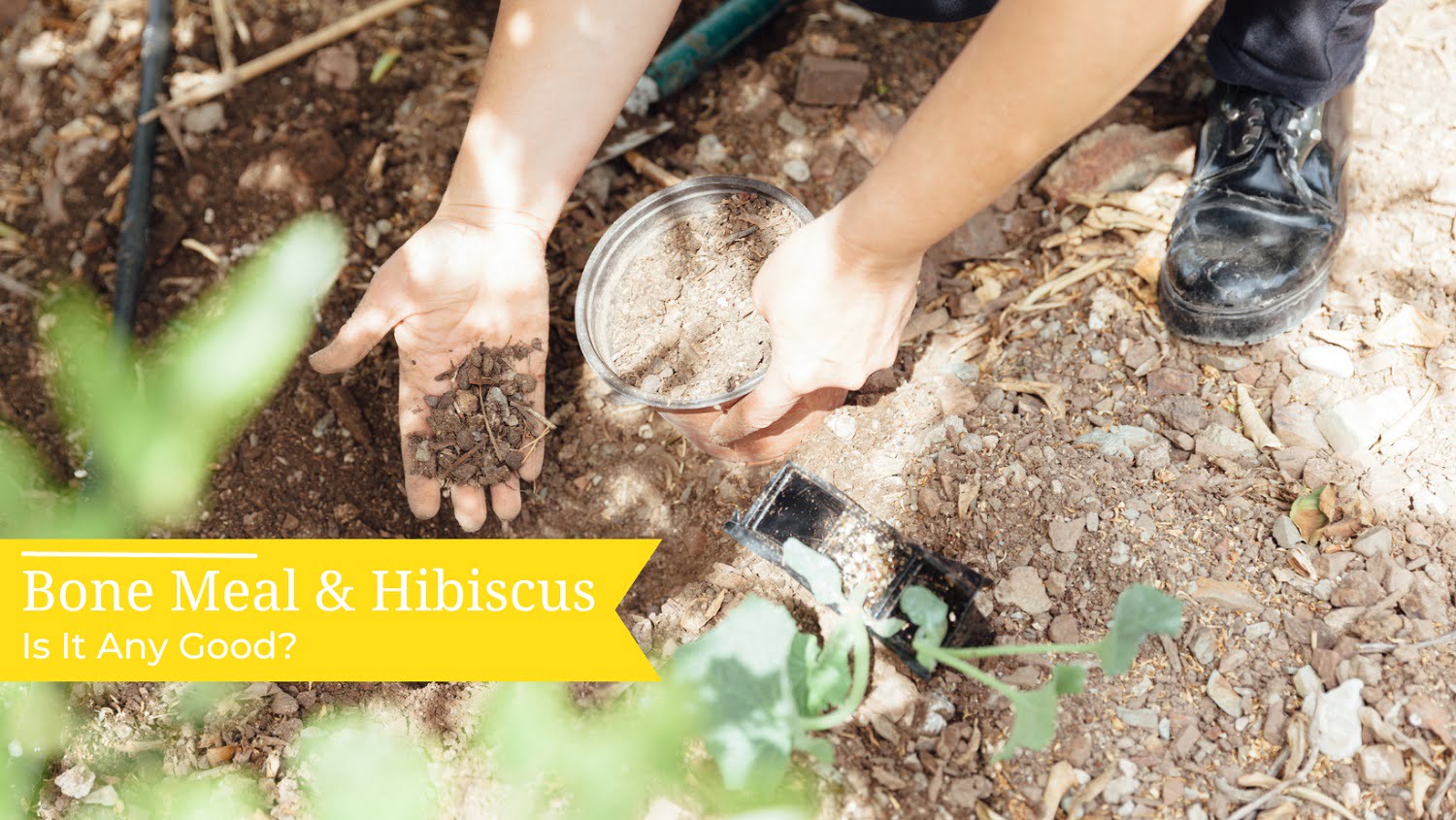
Be it your balcony or the backyard, as a gardening enthusiast it is quite common to quickly resort to fertilizers as a way to replenish your Hibiscus’ nutrient intake. After all, you want the best for your little fellow so that it blooms throughout the year. That said, when it comes to bone meal, there are few things that you should keep in mind.
So, here we are again, with all the facts related to bone meal and its effect on Hibiscus. Keep on reading further to get a detailed insight!
What Is Bone Meal?
Fertilizing with bone meal is a secret recipe among gardeners and a tradition that dates back hundreds of years. In fact, it was used way before commercial fertilizers were known or even existed.
Bone meal is made primarily from the bones of animals. They are milled into various grades and then sold as fertilizer for crops. The N-P-K ratio of bone meal ranges from 2-15-0 to 3-25-0, depending on the manufacturing process or bone content, and contains about 10-12% calcium.

The nitrogen content present in this fertilizer is in organically bonded form and is mineralized relatively quickly once added to the soil. Phosphorus, on the other hand, is bound to calcium in bone meal and thus has the same bonding as the poorly soluble calcium phosphates of rock phosphates.
This phosphate has a very slow fertilizing effect compared to the water-soluble phosphate fertilizers, and is even much lower on soils with pH values of 6.5 and higher.
However, the content of heavy metals in bone meal is very low. So, unlike most mineral phosphate fertilizers, bone meal is practically cadmium-free and therefore does not lead to cadmium contamination in the soil, even with long-term application.
Now that you are familiar with the contents of bone meal, let’s see what effects it has on Hibiscus.
Effects Of Bone Meal On Hibiscus
During its growth, Hibiscus extracts nutrients and minerals from the soil. In its natural cycle, the dead leaves and the bacteria surrounding it ensure that they become nutrient-rich humus again. However, if this cycle is disrupted, a nutritional deficiency may occur.
Or it may be the case that a particular nutrient or mineral is especially needed due to a stressful situation such as a disease, prolonged rainfall, excessive heat or an aphid infestation. This must then be supplied additionally as a mineral, i.e., inorganic form, as this is the only way to revive your Hibiscus.
As for bone meal, its main function is to replenish the phosphorous supply in soil, but this does not mean that it is an ideal blend to be used as a fertilizer. Bone meal is used primarily on plants that have high phosphorus requirements or the ones that prefer alkaline soils, that is, with a relatively high value of pH.
And even though Hibiscus needs phosphorus as a macronutrient, it is actually more of a potassium-loving plant. Besides, any fertilizer that raises the pH is definitely not appreciated by Hibiscus.
In addition, Bone meal remains in the soil for many months without dissolving. For this reason, it is strongly discouraged to use the soil that was previously treated with bone meal, even two to three years after its application.
Also, being a slow-release fertilizer, phosphorus is supplied continuously over a long period of time, which can lead to leaf burn and, in extreme cases, death of the Hibiscus plant altogether.
Advantages Of Adding Bone Meal On Hibiscus
In addition to calcium and nitrogen, bonemeal contains a relatively high percentage of phosphorus. So, on one hand it provides phosphorus for strong and healthy growth of the roots, while on the other it contributes to the formation of chlorophyll, which is beneficial not only for the leaves but also for the flowers.
The calcium present in bone meal is responsible for stiffening of branches and contributes to its overall growth. Even in the garden or lawns, calcium plays a similar role, as it improves the quality of the soil by stabilizing its composition.
Lastly, nitrogen, which is considered one of the most important plant nutrients, is essential for the overall growth of plants and is therefore needed by Hibiscus in several ways to maintain its overall health. A deficiency of nitrogen in the soil becomes noticeable very quickly, especially when Hibiscus is grown in pots.
Some of the benefits of using bone meal include:
- Long-term benefits due to slow decomposition
- Natural ingredients
- Easy to use
- High content of calcium and phosphorus
- Derived using simpler techniques
- Is relatively cheaper than inorganic fertilizers
All in all, bone meal provides hibiscus with important nutrients such as phosphorus, calcium and nitrogen, all of which promote healthy growth and enhance the quality of the soil.
Important– These benefits can only be reaped on a soil that is low in phosphorus content. If your soil is already rich in phosphorus, adding bone meal can have serious consequences. Our next section will help you understand the adverse effects of bone meal on hibiscus.
Disadvantages Of Adding Bone Meal On Hibiscus
Bone meal is a good source of calcium and thus contributes in raising the pH of the soil over time. And while it does not immediately reduce the acidity of the soil, as it takes time for bonemeal to combine with the soil – But over time, it will alkalize the soil completely.
About six kilograms of bone meal is enough to raise the pH of about 50 square meters of lawn.
And as the name indicates, bone meal is made from the bones of animals. These are crushed and then sold as fertilizer. But ever since Bovine Spongiform Encephalopathy (BSE) or Mad Cow disease emerged as a threat, a large number of gardeners and farmers have discontinued its use.
The risk that bone meal could contain dangerous pathogens is far too great compared to its benefits. Especially if you are growing hibiscus to be used in the preparation of tea or personal skin care products. It is therefore advisable to resort to alternatives rather than bone meal.
Some side effects of using bone meal on hibiscus are:
- If used improperly, nitrogen can also be leached from bone meal, polluting groundwater
- Carries the risk of dangerous pathogens
- Slow acting and therefore not helpful when immediate nutrition is required
- Makes the soil alkaline, something not preferred by hibiscus
- The rate of disintegration depends on the temperature and humidity
- Useful only if the treated soil is adequately supplied with all other nutrients
- Can kill the hibiscus entirely due to excessive phosphorus fertilization
Should I Put Bone Meal In My Hibiscus?
Modern day bone meal consists of little nitrogen, zero potassium, and a high degree of phosphorous. This high degree of phosphorous is only made available to plants if the soil is highly acidic in nature.
Furthermore, if you are already treating your garden or pots with organic manure or inorganic fertilizers like NPK or DAP, it is highly unlikely that your Hibiscus is deficient of phosphorous.
And even if you believe that your Hibiscus needs a certain degree of phosphorous, the nitrogen content in bone meal is simply not enough to help your plant absorb the required phosphorous from it.
Moreover, feeding too much phosphorus to your Hibiscus harms mycorrhizal symbiosis, which plays a critical role in absorbing nutrients from the soil.
And while we agree that bone meal contains calcium which is quite beneficial to the Hibiscus plant, but isn’t calcium already found in abundance in most soils?
In short, there is no particular requirement to add this nutrient externally.
So, adding bone meal to your Hibiscus is a waste of efforts as well as money. If you want to enrich your soil to ensure perfect blooms all year round, always prefer a fertilizer that does not contain too much phosphorus. Remember, the quantity of phosphorous should be lower than Nitrogen or, at most, about equal.
But in case you already have bone meal and want to test its efficacy on Hibiscus, make sure to add a nitrogen-rich fertilizer along with potassium at the same time (something like 13-0-45).
Bottom Line
People are often recommended to use bone meal while their Hibiscus is at the growing stage, as it encourages root development.
However, the notion that a high percentage of phosphorus is essential for rooting is nothing but nonsense.
Well yes, a certain amount of phosphorus must be present in the soil, just like other macro and micro nutrients including potassium, nitrogen, iron, magnesium and calcium to promote rooting, but not in excess.
The use of fertilizers with Nitrogen-Phosphorous-Potassium ratios of low-high-low should be completely avoided on Hibiscus altogether. This applies to both organic as well as inorganic fertilizers.
So, if you are thinking about adding bone meal to your Hibiscus plant, you may want to hold this thought as it is nothing but a wastage of money and your valuable efforts.
Gardening Tip– Banana peels work wonders for hibiscus soil. And it is a great alternative to bone meal!
Happy Gardening





